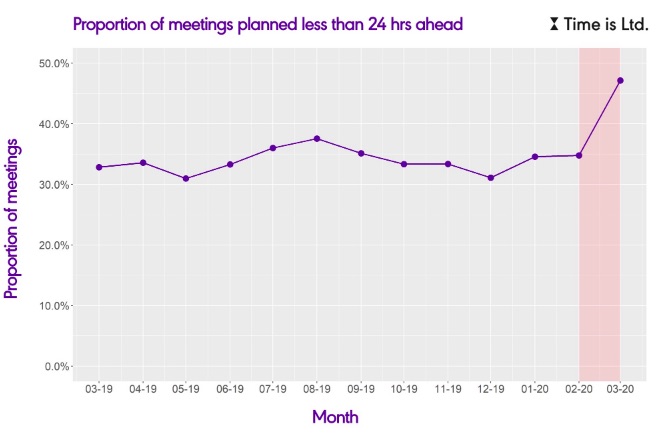
The great work from home experiment is heading into month three for most people. As companies consider a halting return to offices, they’re also taking stock of an essential question: Is remote work more productive?
Ask employees and, surprise, you’ll get mixed responses. Those who are new to remote working, rather than grizzled vets, struggle more with productivity: Nearly one-third of people who have been working remotely for a month say it has negatively affected their productivity, according to instant messaging tool Slack. Only 13% of experienced remote workers feel the same.
What’s more, the view of work from home is colored by, well, your home. If you’re sorted on child care and working from the study of your vacation home, you might think this remote work world is absolutely the future. If you’re a harried lower-rung employee in a cramped apartment, juggling endless work Zooms with elementary school Zooms, you might have another view.
That’s made blanket productivity approaches hard to pull off for companies. To adapt to changing employees’ needs, companies are shortening meeting length, relaxing the end of the working week and making a point of leading by example in taking time to decompress.
“I’ve heard from a few companies that they are more productive in a work-from-home environment,” said Jan Rezab, CEO of productivity analytics platform Time is Ltd. “I challenge them on how they measure that. Really. And they say communication frequency has gone up. But that’s not productivity.”
While in lockdown, people are having more, larger meetings. Instances of meetings with over eight people increased by 14.4% in March, according to Time is Ltd. People are having more recurring meetings: 38.1% of meetings were recurring in February compared with 47.2% in March.
“More virtual meetings do not equal greater productivity or being more ‘present,'” said GroupM U.S. chief marketing officer Jill Kelly. “Productivity is in the accountability assumed and the work done. It’s not defined in a meeting roll call.”
Meeting planning has become more frenetic too: Companies are scheduling almost half of their time less than 24 hours in advance, up from just over a third in February, according to Time is Ltd.

“That’s a pretty hectic schedule,” said Rezab. “You might be able to keep it for a month or three but if you’re going to be keeping it long term that’s not healthy for you.”
Making sure people take time to refresh when they need it to avoid burnout is hard to enforce. Executives are finding it more influential if they set the tone themselves.
“I block out a fake hour and a half meeting for all my direct reports,” said Joy Robins, chief revenue officer at The Washington Post. “It puts that time on hold in their calendar to take the time out, and I see them pass it forward [to their direct reports]. More than ever it’s important to lead by example. People are taking what I do and say and really applying it to their teams.”
The challenges in having to quickly find new ways of generating revenue have made teams in media companies and agencies produce more, whether that’s more feelgood content, virtual events or advertising products to meet the new consumer needs.
“It’s important to recognize that the measure of productivity is on the output versus how a project is completed,” said Kelly. “Projects now come together in new ways, or during off-hours. There is a greater reliance on team alignment against deadlines and deliverables.”
Dennis Publishing has maintained its four calls a week with the commercial team — around 100 people — since lockdown began. But the meetings have got shorter, sometimes only five minutes at the beginning of the week to outline the revenue goals. If these are met, which they mostly have been, the working week finishes early at 4 pm on Friday. This helps as the previously hard edges of the day have softened with people work longer hours.
“There isn’t any substitute for face-to-face and immediate collaboration,” said Jonathan Kitchen, chief revenue officer at Dennis. “We’re probably more formal on productivity. When you are on a call with the team you actively listen more.” Dennis blocks out 30-minute-long meeting slots. Typically, sources say people can concentrate for 20 minutes on a video call before the mental load takes its toll.
On the more draconian end of the spectrum, businesses have been panic-buying employee surveillance software to keep tabs on staff productivity while remote working. Axos Bank CEO sent an email warning that individuals are “taking advantage” of flexible work arrangements. It’s now monitoring of employees. And software sales have soared: Employee monitoring system ActivTrak’s inbound requests have tripled in recent weeks from 50 to 800 in March. HubStaff said unique visits are up 72% in the last three weeks compared to the previous period. One U.K. public relations agency CEO suggested having a video conference call open all day to emulate the office environment, an offer quickly shut down by the employees. Another tech platform has implemented the same and is seeing positive results, leading to more natural office “banter.”
Ultimately, the differences in approach to productivity boil down to trust. Introducing new surveillance would have damaging impacts on employees’ relationships with their company, according to 65% of workers from a 2018 study by the U.K. Trades Union Congress. Finding the right balance in responding to employees’ needs has never been tougher, and right now, there’s a microscope on how corporations navigate this crisis.
“The larger picture is of increased brand accountability,” said associate insight director at behavioral agency Canvas8 Helen Jambunathan. “We see that as part of the pandemic, people are really holding brands to account. Not just in their advertising, marketing and communications but around their own employment practices and a greater social good.”
More in Media

Podcast companies turn to live events to capture growing advertiser spend
The surge in the number of live podcast events in 2025 reflects a broader shift: advertisers are betting bigger on podcasts — not just as an audio channel but as a full-fledged creator economy play.

Media Briefing: ‘Cloudflare is locking the door’: Publishers celebrate victory against AI bot crawlers
After years of miserably watching their content get ransacked for free by millions of unidentified AI bot crawlers, publishers were finally thrown a viable lifeline.

How Vogue could navigate potential industry headwinds as Anna Wintour — who agency execs say made ad dollars flow — brings on new edit lead
Anna Wintour’s successor at Vogue will have to overcome the myriad of challenges facing fashion media and the digital publishing ecosystem.








